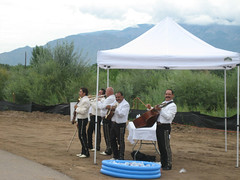I have ridden my bicycle in and around Albuquerque, New Mexico, for many years, and I can confidently say that yesterday was the first time I have ever been serenaded by mariachis as I rode. (Miguel and I were riding past the Alameda Open Space Saturday, where a bunch of folk were putting on some sort of water-related fiesta.)
More Stuff I Wrote Elsewhere
Winter droughts apparently bring summer rains in New Mexico. That, dumb luck and a bit of mystery are scientists’ best explanations for this year’s prodigious monsoon, which looks like one for the record books.
“We’re on track for our wettest summer ever,” said Charlie Liles, head of the National Weather Service’s Albuquerque office.
Whether the luck counts as bad or good depends on whether you’re enjoying the rainy respite— or digging mud out of your living room.
Stuff I Wrote Elsewhere
The New Mexico Office of State Engineer (the water people) issued a report last week looking at climate change impacts and vulnerabilities. From the story by Tania Soussan and myself:
Global warming is likely to increase the risk of drought in New Mexico over the next century, and mountain snowpacks anywhere south of Santa Fe could be a thing of past by the late 21st century.
Those are among the conclusions in a new analysis by the state Engineer Office, which offers a detailed New Mexico perspective on the international scientific community’s latest projections of climate change induced by greenhouse gases.
Farmers, ranchers, wildlife and city water supplies could all suffer, according to the report.
More from Dessler
Andrew Dessler adds a helpful coda to his comments in my newspaper story of a couple of weeks back:
I agree with Pielke Sr. that assessments have to include the range of opinions held by the majority of the scientific community. If half of the community says one thing and the other half says something else, then a good assessment will include both views. My sense is that the recent AGU assessment on hurricanes failed in this regard (see also this Prometheus post).
However, we have to be careful about including views that are “too diverse.” The goal of a scientific assessment is to let policymakers know what the scientific community thinks on an issue. If 99.9% of the scientists think one thing (e.g., the Earth is warming), then should the assessment include a dissenting view held by 0.1% of the community? I would argue not. Policymakers are often unable to discern a 99.9% position from a 0.1% position, and they look to expert assessments to do just that. If they don’t, then the assessment has essentially abdicated its responsibility to clarify the science for the policymakers.
Chat the Monsoon
Over where they pay me, I’ll be doing an on line chat tomorrow at 1:30 p.m. MDT on the science of the monsoon. If needed, I’m fully prepared to defend the ill-defined term.
Santa Ana Winds and Climate Change
Last February, Kit Stolz blogged about evidence that California’s fire-bringing Santa Ana winds (SAO is the acronymic jargon) were shifting later in the year. There’s a new paper in GRL suggesting a link between climate change and the shift:
This initial analysis shows consistent shifts in SAO events from earlier (September–October) to later (November–December) in the season, suggesting that SAOs may significantly increase the extent of California coastal areas burned by wildfires, loss of life, and property.
(My previous blogging on the subject.)
Water in the Desert
The always insightful* Coco offers some helpful backstory to the institutional arrangements responsible for sucking water out of Albuquerque’s low-lying neighborhoods:
One of the strongest reasons behind having growth management is to plan public infrastructure investment to assure adequate funding for replacement and repair of things like aging infrastructure that serves existing neighborhoods – like storm drainage pumps near Martineztown.
She’s talking about Dan McKay’s excellent story in this morning’s paper explaining how the pumps in Martineztown didn’t work over the weekend – and why.
* except when she’s capping on the Journal, then she’s totally not insightful 🙂
Yet More on the Newspaper Story that Shall Not Die
More discussion over on the Fix about my July 23 story on climate science.
On The Joys of Technical Writing
For my friends who churn out words and wonder why, Aaron’s writerly observations on ambitions and life:
I dream of writing the Next Great Marketing Brochure. I know exactly what it’s like: it’s about five hundred words long, and it’s printed on glossy cardstock. People line up at trade shows to get a copy, and when they open it up, they follow the instructions I provide: read me, buy me, love me.
Water in the Desert
Calling Durango, Colorado, “the desert” is a bit of a cheat. Located on the edge of the San Juan Mountains, it averages 20 inches or so (50 cm) of precipitation a year, well above what might formally qualify as desert. But Durango sits at a fulcrum in the complex interplay between climate and geography in the arid west.
With the intake structure for the Animas-La Plata Project, one of the west’s last great water projects, taking shape on Durango’s southern edge, the city also sits at a fulcrum of the complex interplay between climate, geography and engineering that has come to define life in the arid west.


